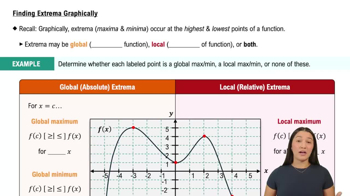Table of contents
- 0. Functions7h 52m
- Introduction to Functions16m
- Piecewise Functions10m
- Properties of Functions9m
- Common Functions1h 8m
- Transformations5m
- Combining Functions27m
- Exponent rules32m
- Exponential Functions28m
- Logarithmic Functions24m
- Properties of Logarithms34m
- Exponential & Logarithmic Equations35m
- Introduction to Trigonometric Functions38m
- Graphs of Trigonometric Functions44m
- Trigonometric Identities47m
- Inverse Trigonometric Functions48m
- 1. Limits and Continuity2h 2m
- 2. Intro to Derivatives1h 33m
- 3. Techniques of Differentiation3h 18m
- 4. Applications of Derivatives2h 38m
- 5. Graphical Applications of Derivatives6h 2m
- 6. Derivatives of Inverse, Exponential, & Logarithmic Functions2h 37m
- 7. Antiderivatives & Indefinite Integrals1h 26m
- 8. Definite Integrals4h 44m
- 9. Graphical Applications of Integrals2h 27m
- 10. Physics Applications of Integrals 2h 22m
5. Graphical Applications of Derivatives
Intro to Extrema
Problem 4.1.21
Textbook Question
Sketch the graph of a continuous function ƒ on [0, 4] satisfying the given properties.
ƒ' (x) and ƒ'3 are undefined; ƒ'(2) = 0; has a local maximum at x= 1; ƒ has local minimum at x = 2; and ƒ has an absolute maximum at x= 3; and ƒ has an absolute minimum at x = 4 .
 Verified step by step guidance
Verified step by step guidance1
Identify the critical points and intervals based on the given properties. The critical points are x = 1, x = 2, x = 3, and x = 4. The intervals to consider are [0, 1], [1, 2], [2, 3], and [3, 4].
Analyze the behavior of the function on each interval. Since ƒ'(2) = 0, the function has a horizontal tangent at x = 2, indicating a local minimum. At x = 1, the function has a local maximum, so the derivative changes from positive to negative.
Consider the absolute maximum at x = 3. This means that the function value at x = 3 is greater than or equal to the function values at all other points in the interval [0, 4].
Note that the function has an absolute minimum at x = 4. This implies that the function value at x = 4 is less than or equal to the function values at all other points in the interval [0, 4].
Sketch the graph by plotting the critical points and ensuring the function is continuous. Start with a local maximum at x = 1, decrease to a local minimum at x = 2, increase to an absolute maximum at x = 3, and finally decrease to an absolute minimum at x = 4.
 Verified video answer for a similar problem:
Verified video answer for a similar problem:This video solution was recommended by our tutors as helpful for the problem above
Video duration:
7mPlay a video:
Was this helpful?
Key Concepts
Here are the essential concepts you must grasp in order to answer the question correctly.
Derivative and Critical Points
The derivative of a function, denoted as ƒ'(x), represents the rate of change of the function at a given point. Critical points occur where the derivative is zero or undefined, indicating potential local maxima, minima, or points of inflection. In this question, understanding that ƒ'(2) = 0 and that ƒ' is undefined at certain points is crucial for identifying where the function changes behavior.
Recommended video:

Critical Points
Local and Absolute Extrema
Local extrema refer to points where a function reaches a maximum or minimum value within a specific interval, while absolute extrema are the highest or lowest values of the function over its entire domain. The question specifies that there is a local maximum at x=1, a local minimum at x=2, an absolute maximum at x=3, and an absolute minimum at x=4, which guides the sketching of the function's graph.
Recommended video:

Finding Extrema Graphically
Continuity of Functions
A function is continuous if there are no breaks, jumps, or holes in its graph over a given interval. For the function ƒ on [0, 4], continuity is essential to ensure that the graph can be drawn without lifting the pencil. This property, combined with the specified critical points and extrema, helps in accurately sketching the function's behavior across the interval.
Recommended video:

Intro to Continuity

 5:58m
5:58mWatch next
Master Finding Extrema Graphically with a bite sized video explanation from Callie
Start learning




